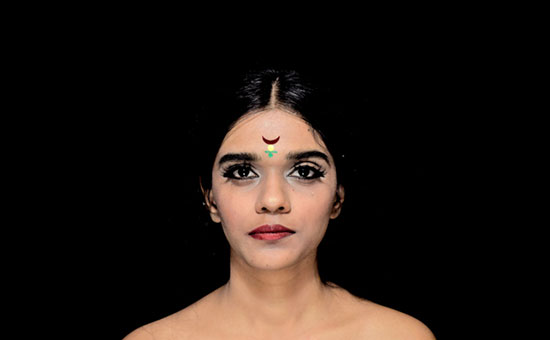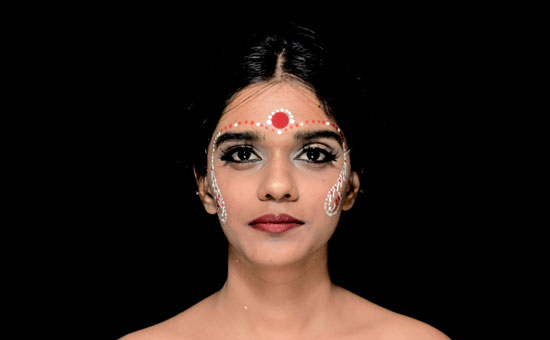Bindi, has over time, become synonymous with Indian culture and its
appropriation has been stretched to an extent where we often ignore or refuse
to acknowledge its purpose or historical context.
However, Bindi’s past, present, and all its attributes are as vibrant as the colors it often displays.
This article is authored by Anmol Bains, Mohiba Urooj and Muskaan
Kargwal.
Symbolizing many aspects of Indian culture, the distinct dot placed between the eyebrows is an age-old Indic tradition known as a “Bindi” which comes from the Sanskrit word “Bindu” meaning “a point, dot, drop or small particle”.
The word can be traced back to the hymn of creation - Nasadiya Sukta in
Rig Veda (Approx. 1500 BC).
Bindi is popular within cultures of the Indian Subcontinent. It is
associated with the Ajna Chakra, the mystical third eye- the seat of concealed
wisdom and also as the center of the creation of Mandala, the Universe.
The Bindu
with kumkum is the esamskriti logo. It can have 5 meanings, that can be read here
Sanjay Rao wrote, “The bindu can be interpreted as 'zero' 'or 'decimal'.
Indian 'Mathematicians' were not mathematicians in the general sense of the term as meant by Western mathematicians. The Indian mathematicians were in reality Yogic seers, Mystics, people who understood the nature of the universe far beyond what the rest of the world could comprehend. These amazing people were able to express most of the structure of the universe and creation in the language of math.
The concept of Zero, also called shunya is not just a mathematical concept, but
originated as a spiritual explanation of the nature of the universe in
Hinduism.
The shunya, or shunyatam (in Tamil philosophy) or Zero in English was
propounded by them as the starting point and the ending point, the true nature
of everything in this universe. That emptiness from which everything emerged
and into which everything will collapse in unending cycles. That emptiness
which is the true nature of all objects, the object itself being illusion or
maya.
In addition to zero they came up with another concept called the decimal or the bindu without which again no math in this universe will exist.”
Although rooted in the Hindu tradition, Bindi has gradually transformed
from a traditional marker of the marital status of women to a fashion
statement, a symbol of health and hope.
Series 'B I N D I ' is a collection of images that display the evolution of Bindi over the years. To see photo album click here
Bindi is known by several names in Indian languages such as Tilak,
Pottu, Alpana, and Kunkoo, indicating the deep roots of this tradition.
This series focuses on Bindi/Tilak representing different sampradyas and
marital status.
Bindi has become an extension of one's personality in the world of television and cinema and evolved into a fashion accessory. And as a contributor to wearable technology by serving as the Life-saving dot used to get more iodine through skin absorption.
Contrary to popular belief, it isn’t only women that wear Bindi, men do so as well.
It may sound uncanny, given our familiarity with the more popular term ‘Tilak’ for men but Tilak and Bindi are by definition synonyms. While it is worn by Hindu men on their foreheads on special occasions, the color and form could vary with caste, religious sects, and the form of the Lord worshipped. In Andhra Pradesh men wear round bindis.
Vaishnavism, Shaivism, Shaktism, and Trimurty symbolism were four
devotional sects of Hinduism, each with a distinct style of Tilak.
The Varna system that categorically identified men based on the role and
function they performed in the society used Tilaks in different colors to
denote their caste.
Brahmins, who were the priests and teachers, sported a white Tilak which
symbolized purity and divinity. Red, being the color of passion and heroism,
was the color of Tilak for Kshatriyas-the warriors. Vaishyas, the traders, put
a yellow-colored Tilak as a sign of prosperity, and Shudras would put a black
colored Tilak of Bhasm.
In the case of women, Bindis in different colors were meant to represent
marital status. A red kumkum Bindi was attributed to married women. An absence
of Bindi or a black one represented unmarried women, and a white sandalwood
Bindi announced women who preferred celibacy or were widows.
The regional variation of Bindi is particularly interesting for their
peculiar cultural significance.
 Marathi bindi.
Marathi bindi.
The Marathi Bindi, Chandrakor,
is curiously shaped like a large crescent moon with a dot above or beneath that
is associated with Chandrabindu and Bindu chakra.
 Bengali bindi.
Bengali bindi.
In Bengal, a large red Bindi is worn and is complemented with Alpana
designs that cover the forehead and cheeks, for the brides.
 Rajasthani bindis.
Rajasthani bindis.
Rajasthani Bindis are often studded, long, and sometimes
crescent-shaped. Smaller red Bindi with white Tilak at the bottom of the
forehead is more common in the regions of southern India.
The power of a simple dot over a forehead mixed with a specific design
or color was properly highlighted by the Indian big and small screen.
Whereas heroines like Rekha and Sridevi sported glamourous gemstone
Bindis to portray their sensual sexuality, on the smaller screen it was mainly
used to represent the good and the evil as shown by Komolika in Kasauti Zindagi
Ki where she wore large dark-colored Bindis to portray maliciousness and
inherent evil.
The movie Bahubali took the
use of Bindi a step forward as every character wore a Bindi or Tilak carefully
crafted to portray the personality of their character.
But in popular culture Bindi has not just been used as a creative tool
to add definition to a character but also as a celebration of culture like in
the case of Usha Uthup.
More recently, the popularity of Bindi outside the subcontinent has
become stronger, with international stars such as Miley Cyrus rocking sticker
style Bindi. An emergence of similar decorative designs was also seen in
Halloween parties and Pride parades. More often than not, these are devoid of
any cultural or religious significance and have become a topic for debates as
to whether they are cultural appropriations.
As millions of people in India suffer from Iron deficiency, The
Life-saving dot- a Bindi patch with Iodine, aims to help the more vulnerable
group of pregnant women by providing the required amount of iodine per day.
This idea was formulated by the Singaporean agency, the Grey group, and
launched as a collaborative campaign with the NGO, Neelvasant Medical Foundation,
and Research Centre.
Bindi has been around for millennia, however, with the genesis of true
globalization, wherein cultures interact on much freer platforms, Bindi is on
the verge of losing its true identity. We must wonder, at this point, that by
being so versatile, full of so much variety, does it retain its true identity?
What if the versatility of the Bindi, its use as a symbol denoting
identity whether it be the maliciousness of Komolika, the piousness of a South
Indian priest, the bravery of a Rajput warrior, or the freedom of an LGTQ
activist.
In a dot lies the meaning of the universe, the purpose of wisdom, and
the concept of identity.
Perhaps if we can sing to the newer generations of this small dot’s significance and history, they will sing it to theirs and keep this tradition going, crossing oceans and cultures and time to keep the tradition alive.
Authors are students of different colleges. Pictures courtesy and copyright Anmol Bains. Model is Muskaan Kargwal, Mohiba Urooj is Production Assistant.